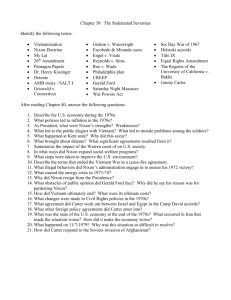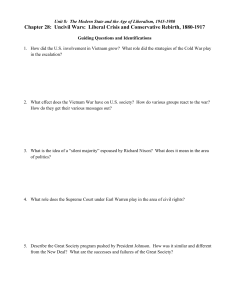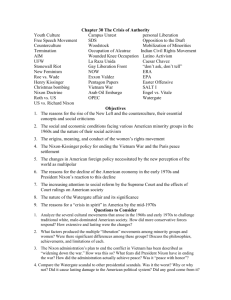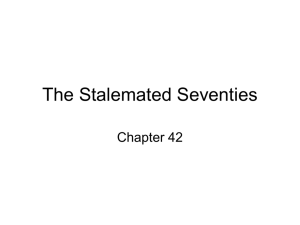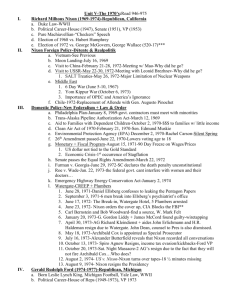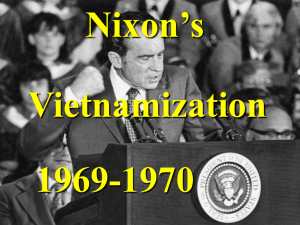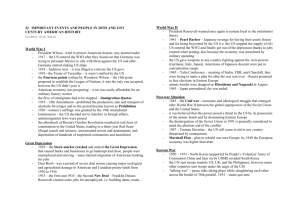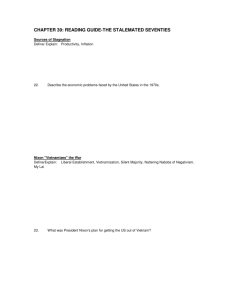Chapter 39 PowerPoint - Clear Falls High School AP US History
advertisement
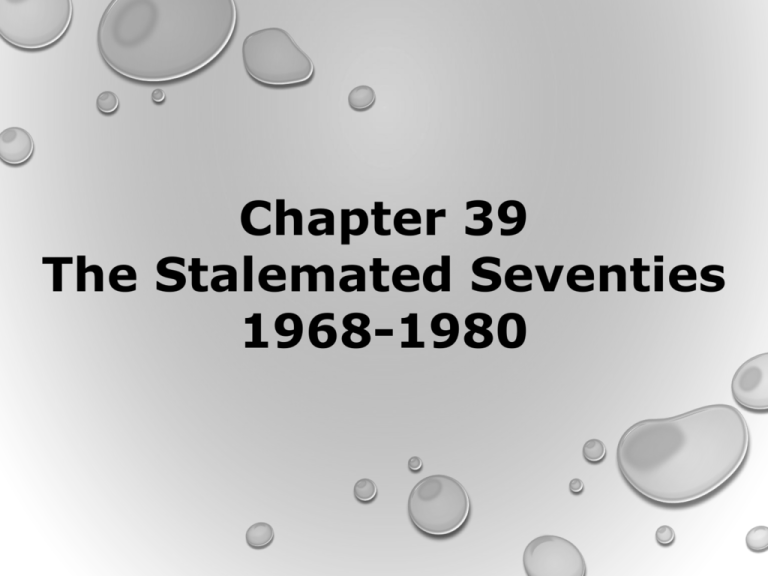
Chapter 39 The Stalemated Seventies 1968-1980 The 1973–75 recession or 1970s recession was a period of economic stagnation in much of the West during the 1970s, putting an end to the general post-World War II economic boom. It differed from many previous recessions as being a stagflation, where high unemployment coincided with high inflation. The period was also described as one of "malaise". Among the causes were the 1973 oil crisis and the fall of the Bretton Woods system. On 15 August 1971, the United States unilaterally terminated convertibility of the US Dollar to gold and saw the dollar become fiat currency. This action, referred to as the Nixon Shock, created the situation in which the United States dollar became a reserve currency used by many countries. The emergence of newly industrialized countries increased competition in the metal industry, triggering a steel crisis, where industrial core areas in North America and Europe were forced to re-structure. “Nixon Doctrine” Three key points of the Doctrine were: 1. Negotiating with adversaries, regardless of their philosophy of government, an attempt to find some common ground for agreement and mutual benefit. 2. Working for a greater partnership with U.S. allies, in which each nation is encouraged to make a greater contribution toward its own defense. 3. Preserving America’s strategic strength for security. The U.S. maintains its arms as a “bargaining chip” while attempting to reduce the overall level of strategic weapons among all nuclear nations and working toward universal control of weapons in space and on the ocean floor. The stated goals were to promote democracy and economic development in nonaligned nations by providing foreign aid. In practice it supported many repressive unpopular governments. The U.S. furnished military and economic aid to any government that was pro-US and anti-communist. 3 January 20, 1969 President Richard M. Nixon, promised to achieve "Peace With Honor." His aim was to negotiate a settlement that would allow the half million U.S. troops in Vietnam to be withdrawn, while still allowing South Vietnam to survive. Nixon launched a “Vietnamization” of the war. This meant most of the fighting would be done by South Vietnamese (ARVN) forces with the U.S. providing support. The major elements of Vietnamization were the improvement and modernization of the South Vietnamese armed forces ability for pacification and combat operations. 4 The Cambodian Invasion: Nixon authorized secret bombing of Cambodia in early 1969 to destroy communist bases. The invasion of Cambodia (4/29/1970 to 6/29/1970) by U.S. and ARVN troops was the first real test for Vietnamization. The overall performance of ARVN troops had been termed disappointing to mediocre by U.S. military advisors who served with ARVN units. Domestically, negative reactions to the Cambodian incursion, including the killing of four students at Kent State College in Ohio became a major factor in Nixon's decision to accelerate the withdrawal of U.S. forces from South Vietnam In May of 1970, a Kent State University anti-war (Cambodian invasion) protest turned deadly. National guardsmen opened fire on protesting students killing four and wounding 8. The Pentagon Papers: History of the political-military involvement in Vietnam from 1945 to 1967. The papers were discovered and released by Daniel Ellsberg, and first brought to the attention of the public on the front page of The New York Times in 1971. The Pentagon Papers had demonstrated, among other things, that the Truman, Eisenhower, Kennedy and Johnson Administrations "systematically lied, not only to the public but also to Congress.“ More specifically, the papers revealed that the U.S. had secretly enlarged the scale of the Vietnam War with the bombings of nearby Cambodia and Laos, coastal raids on North Vietnam, and Marine Corps attacks, none of which were reported in the mainstream media. The end in Vietnam Nixon’s plan of talking and bombing led to results in the Paris Peace talks which had been going on since 1968. North Vietnam was pressured by both the USSR and China which led to a final agreement and ceasefire in January of 1973. The treaty allowed the U.S. to withdraw almost all of its troops. Unfortunately for South Vietnam, the North Vietnamese led a massive invasion in April of 1975. Communist forces entered the South Vietnamese capitol city of Saigon on April 30, 1975 and renamed it Ho Chi Minh City. Vietnam was reunited under a communist government. The U.S. mission to protect South Vietnam had failed. Cambodia and Laos also became communist states the same year. 6 January 1, 1972 Two-thirds of America's troops were removed in only two years. The ground war was then almost exclusively the responsibility of South Vietnam, which had over 1,000,000 men enlisted in its armed forces. The human cost of the Vietnam war. U.S. battle deaths 1960-1972. 7 Why did Nixon reverse U.S. China policy in 1971? China was the most populous nation in the world and it made no sense not to have diplomatic and commercial relations China and the USSR were not on friendly terms and the U.S. could play them off against each other Nixon’s history of anti-communism allowed him to normalize relations with China without being accused of being “soft on communism” 8 Détente: RELAXING OF TENSIONS BETWEEN NATIONS President Nixon improved relations with the U.S.S.R. Nixon visited Moscow Wheat deal Leonid Brezhnev visited the U.S. in 1973. Soviet leader Leonid Brezhnev visited the U.S. Helsinki arms control talks and the SALT I treaty 9 Wheat deal The U.S. agreed to sell the U.S.S.R. over a billion dollars in wheat to feed the Russian people. Helsinki arms control talks and Salt I Treaty To cool the arms race between the U.S. and U.S.S.R. a series of strategic arms limitations talks were held from November 1969 to May 1972. This was the first agreement to place limits and restraints on some of the most important armaments. After the wheat deal Russia became more cautious in promoting communist revolutions in third world countries and helped get North Vietnam to the bargaining table. The wheat deal helped American farmers who were struggling with a surplus of wheat. This deal also led to U.S. oil drilling equipment being sold to the U.S.S.R. to help them develop their oilfields in Siberia. The Anti-Ballistic Missile Treaty (ABM Treaty or ABMT) was a treaty between the United States and the Soviet Union on the limitation of the anti-ballistic missile (ABM) systems used in defending areas against missile-delivered nuclear weapons. Under the terms of the treaty, each party was limited to two ABM complexes, each of which were to be limited to 100 anti10 ballistic missiles. Roe v. Wade, 1973 This was a controversial case that dealt with the right to privacy in the 9th amendment. The 9th amendment states: The enumeration in the Constitution, of certain rights, shall not be construed to deny or disparage others retained by the people. The 9th amendment has been used in many cases to justify a citizen’s right to privacy. Roe, a Texas resident, sought an abortion which was against state law in Texas. Roe v. Wade established that a woman’s right to an abortion fell under this earlier guaranteed right to privacy which was protected by the 9th amendment. The ruling gave a woman total autonomy during the first three months of pregnancy and defined various levels of state “interest” during the last two trimesters. This controversial ruling affected the laws in forty six states. War Powers Resolution, 1973 Congress passed this law as a reaction to Vietnam and increased presidential powers. Congress wanted to reassert its war powers The President could send troops overseas where hostilities are imminent without a congressional war declaration only under the following circumstances: Must notify Congress within 48 hours. Must withdraw troops after 60 days (can be extended another 30 days if the safety of the troops requires it) Must consult with Congress if troops are to engage in combat Congress can pass a resolution, not subject to presidential veto, to have the troops withdrawn The Arab Oil Embargo, Organization of Petroleum Exporting Countries (OPEC) October 1973-January 1974 To show support for the armies trying to destroy Israel, Arab petroleum producing nations imposed an oil embargo (a refusal to sell) on supporters of Israel. They also raised prices and cut production to create an artificial shortage. Drivers soon had to wait in long lines and pay very high prices at gas stations. There was little President Nixon could do. 12 Watergate office complex where the Democratic National Committee headquarters were located. Seized wiretapping evidence A security guard noticed an exit door had been taped to keep the latch open. He removed the tape but on his second round found that it had been retaped and called the police. When police arrived, they found five burglars who were attempting to bug the offices of the Democratic National Headquarters. All five men worked for the Committee to Re Elect the President (CREEP), President Richard Nixon's campaign committee. 13 The 22 month investigation involved the press, House of Representatives, Senate, special prosecutors, and the Supreme Court; it uncovered covert action on the part of the president and his advisers. U.S. v Nixon, July 1974 During the investigation it was revealed that there were audio tapes from the White House. Nixon claimed executive privilege in an attempt to keep the tapes secret, however the Supreme Court ruled that executive privilege did not apply in criminal cases and ordered Nixon to surrender the subpoenaed White House tapes to John Sirica, U.S. District Court Chief Judge. The tapes revealed widespread involvement, including by the President. Nixon was forced to resign the presidency on August 9, 1974 because of the Watergate scandal. Gerald Ford was appointed Vice President and later became president after the corrupt Spiro Agnew resigned. 14 Gerald R. Ford became 38th President, August 9, 1974. Ford immediately damaged his Presidency by granting Nixon a pardon Ford-Brezhnev summit meetings: At the meetings both nations agreed to work on a Salt II agreement limiting nuclear warheads and accept the post WWII borders in Europe. The USSR pledged to improve its human rights record. 15 MAD (Mutually Assured Destruction) was a nuclear war strategy used by the U.S. and USSR. MAD meant that if either side started a nuclear missile war they would be assured that both nations would be destroyed. It was a type of deterrence where both nations knew no one would win a nuclear war. A major factor in MAD was the use of multiple independently targetable reentry vehicles (MIRV’s). These multi-warhead intercontinental ballistic missiles would have the capability of breaking into several hydrogen bomb warheads that could hit several targets. MIRV warheads and rockets. Limiting their deployment was a major topic of discussion between Ford and Brezhnev. 16 Camp David Accords The one major success Carter had during his presidency was the 1979 Egyptian-Israeli peace agreement. The Arab-Israeli conflict had been going on since the establishment of the Jewish state in 1948. The refusal on the part of Arab nations to accept the existence of Israel led to four major wars and countless acts of terrorism. In 1977 the world was shocked when Egyptian President Anwar Sadat visited Israel and began peace negotiations. When talks between Begin and Sadat broke down, Carter invited them to Camp David, the presidential retreat in Maryland. After two weeks of intensive negotiations the Camp David Accords were signed. In the Accords, Israel agreed to withdraw from the Egyptian land it had taken in the 1967 war. Egypt agreed to formally recognize Israel’s right to exist. Egypt became the first Arab country to recognize the nation of Israel. 17 1979 January 16: The Shah of Iran fled from Iran and Ayatollah Khomeini returned from exile to establish the fundamentalist Shiite government in Iran on February 26. Khomeini, an Islamic fundamentalist, hated America calling it the ”Great Satan.” He turned Iran into a theocracy where religious bullies enforced harsh Koranic laws. Shah Reza Pahlavi & President Carter Portrait of Khomeini November 4: Iranian militants seized U.S. Embassy in Teheran, took 63 Americans hostage, demanded the return of Shah of Iran, who was in United States for medical treatment. 18 America’s Humiliation 1979: Iranian Muslim fundamentalists seized the U.S. embassy in Tehran, Iran taking 66 hostages. They demanded the U.S. send them the Shah as the price for freeing the prisoners. Carter refused. They would not be released until Jan. 1981 when Ronald Reagan became President. Carter ordered the military to attempt a rescue. This resulted in a disaster when two U.S. aircraft collided, ending the mission before it got off the ground. Eight Americans were killed in the April 24-25, 1980 hostage rescue attempt. 19 Carter and the U.S.S.R. His attempts to continue détente with the Soviet Union failed because the U.S.S.R. continued to support revolutions in Africa. The USSR began deploying medium range nuclear missiles in Europe, forcing the U.S. to respond. Carter and Brezhnev negotiated the SALT II treaty which limited the number of missile launchers and other nuclear delivery systems. The Senate refused to ratify the treaty under the leadership of Senator Henry Jackson. In December 1979, the Soviets occupied Afghanistan and relations between the two super powers chilled and détente suffered a serious blow. To punish the U.S.S.R. for their invasion of Afghanistan, Carter withdrew the Salt II treaty, stopped selling them grain, and declared a boycott of the 1980 Moscow Olympics games. None of these actions had any impact on the Soviet invasion. 20
